

NAPA VALLEY WINE TRAINBy Ted and Sylvia BlishakHighOnAdventure.com December 1, 2010 |
We've written about a number of tourist railroads, but the Napa Valley Wine Train is on the top of our list. Although it started in 1989, we'd delayed riding it, because it is expensive. At $124.00 per person for our Gourmet Lunch in the Dome Car, which included a four-course meal—wine of your choice is extra—it qualified as a special event experience. This made it an excellent choice for a three-generation family reunion. Now that we have enjoyed a sumptuous luncheon trip on board with some of our California family, we have to admit it was worth every penny. The three-and-a-half hour round trip through the Napa Valley starts in Napa and proceeds to its turn-around point at St Helena, passing vineyards dotted with yellow mustard flowers and around 40 wineries along the way. Some look like European villas while others have attractively landscaped gardens with picnic benches for guests. Before the train was ready to board, we met in the company's comfortable and luxurious lounge for complimentary champagne. While there is a gift shop here, which seems to be required for tourist trains, it's tastefully located in a small, separate room. It offers wine for sale, and guests may buy wine here and have it served on board. |
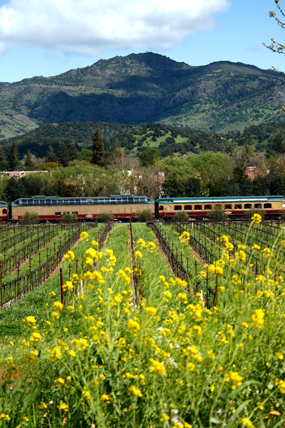 |
|||
Rolling past vineyards and wildflowers |
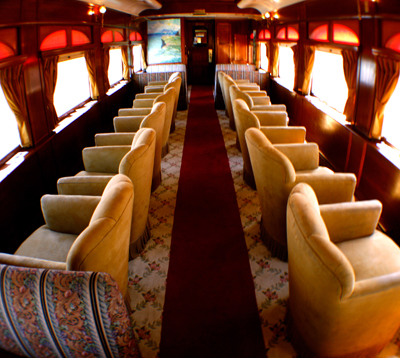 |
This company employs friendly, down-to-earth people who bend over backwards to make guests comfortable, and that starts at the top. For example, when our seven-year-old grand-nephew, Joseph, was walking towards the train, a gust of wind scattered some drawing paper he'd brought along. A tall blond man, a member of the staff, quickly gathered them up and handed them back. "What a nice employee!" commented Sylvia's sister Edy. "He's Greg McManus, the CEO," we explained. (We'd met him earlier when we had a tour of the yards.) Excellence definitely describes the company culture here. A collection of vintage engines and equipment, dating from 1919 onwards—some of which were rusting wrecks at the time this railroad acquired them—have been transformed. The shiny, luxurious carriages have been reborn Cinderella-style, and clearly no expense was spared. |
|||
The 1915 car, fully restored |
Where did the money come from? The founder was Vincent DeDomenico. While his name may not ring a bell, the enterprises that he owned, Golden Grain Pasta (maker of Rice-a-Roni) and Ghirardelli Chocolate, surely will. He sold both to the Quaker Oats Company in 1986, leaving him in the enviable position of being able finance his dream train. It soon became a family project, and various talented relatives pitched in. Some even painted fanciful murals inside the cars. Greg McManus, the President and CEO, is DeDomenico's son-in-law. His job description? "To carry on Vince's dream", he explained. Our family group of seven was seated in two booths across the aisle from each other upstairs in the dome car, which offers the highest class of service. First we enjoyed a local white wine while Joseph, 7, and his brother Alonso, 10, toasted each other with glasses of sparkling cider. We enjoyed a vista of green, rolling hills and yellow wildflowers as we moved along. |
||
| We seven presented a real challenge to our waiter, Gerard: three of our group are vegetarians, one is vegan, and Alonzo has a severe allergy to nuts. But our man handled these complexities with aplomb, and was careful to check with everyone he served to make sure that their meal met their requirements. He even had a special ravioli dish—which was not on the menu—prepared for our vegan niece, Marlene.
Excellence definitely describes the company culture here. Gregg Evensen, the company's Chief Operating Officer (so called partly because his department actually operates the train) and who is also the Chief Mechanical Officer, gave us a tour of the yards and shared some of the NVWT history. |
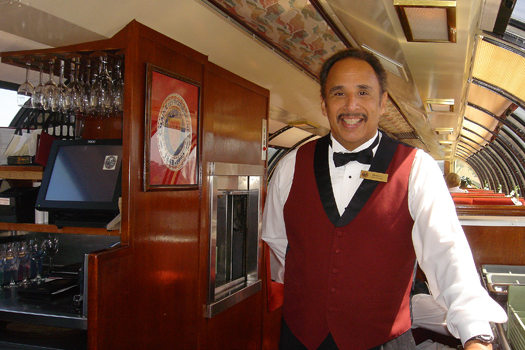 |
|||
Our waiter Gerard |
||||
| First he showed us four 1950s-era engines, all sturdy streamlined diesels. "They've all run five million miles over their expected lifespan; we acquired them from VIA Rail Canada. We removed their old steam generators. With 1800 horsepower, these Alco FPA-4s are geared for 96 mph." (This may be overkill for The Canadian, which makes its leisurely way between Toronto and Vancouver at an average speed of about 30 or 35 mph, but the Alcos were used mostly for the Corridor trains, where their high speed was required.) | ||
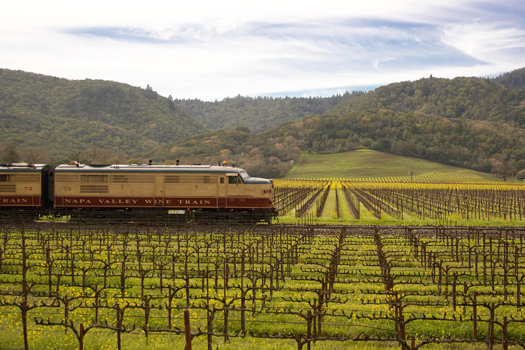 |
"The top speed for the NVWT is 35mph. One engine we cannibalized for spare parts. Engine #73 was, by virtue of a grant, transformed into a clean-air machine. It's equipped with a new engine that runs on compressed natural gas." According to Napa Valley Marketplace Magazine, the gas is compressed to pressures above 3,100 pounds per square inch. Not only can it be produced at a cost lower than gasoline or diesel fuel, it is essentially odorless and smokeless, with about 80 percent less ozone-forming emissions compared to gasoline vehicles. (The company also practices waste reduction by recycling wine and Champagne corks, which are used for shoes, corkboards, and flooring.) "Does the modification make the engine sound different?" Ted wondered. |
|||
Engine 73 is a clean-air engine |
||||
"Yes. We also installed a computer-controlled fuel injection system that fires only a few of the engine's 12 cylinders at a time. It sounds like a dozen motorcycles backfiring out of sync when it's warming up, so get ready to hold your ears—here we go! (By way of contrast, the locomotive with the original Alco V-12 turned over quickly and was quietly burbling in the background.) "There are usually two engines pulling the Wine Train. We always have backup power," says Evenson, straining to make himself heard over the racket. The company's rolling stock was gathered from around North America. "By late summer, 1987, there were 25 restoration specialists working on each car. We maintained the original lighting fixtures and windows whenever possible. And we discovered some amazing artifacts. The car at the rear, the one over there with an open platform, is a vintage 1915 Northern Pacific business car. The restoration team uncovered some semi-circular rose-colored windows. They are still etched with the old Northern Pacific logo. They'd been hidden behind plywood covers for decades. They're still in perfect condition." |
||
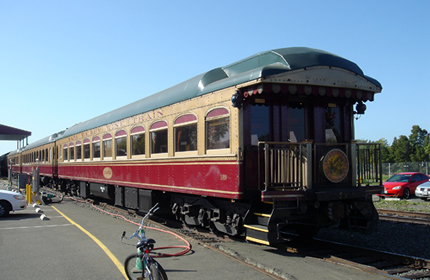 |
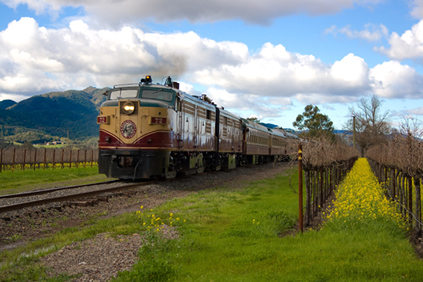 |
|||
Restored 1915 carriage |
Engines were acquired from VIA Rail Canada |
|||
One of Evenson's responsibilities is to keep the vintage engines and carriages maintained, and this is not a skill one can learn from a book. "My father worked here in the beginning, and I learned a lot from him," he said. "One of our biggest challenges is finding compatible parts; frequently we have to have them custom made. "The train has three onboard kitchens. One bakes the fresh bread we serve on board." The railroad's dome car has a lengthy history. Ten were built in 1952 by Pullman Standard for the Milwaukee Road, numbered P50 through P59. They did not have individual names, but were all called by their classification, Super Dome. Napa Valley Wine Train's dome was originally Milwaukee Road P52. |
||
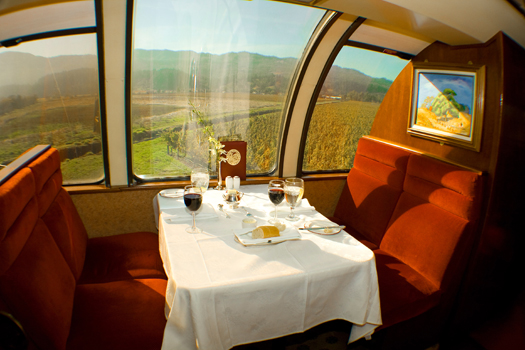 |
||
Inside Dome called CHAMPAGNE |
||
The domes were purchased by Canadian National twelve years later, and named P52 Columbia. It continued to operate when the CN passenger service was taken over by federally-owned VIA Rail Canada. Later, Tour Alaska bought it, renamed it Mt. McKinley, and used it to carry cruise passengers from Anchorage to Fairbanks. P&O Princess Tours acquired the Tour Alaska company, and the Mt. McKinley was barged south and became one of four domes in a new service called the California Sun Express. This short-lived venture operated between Los Angeles and Oakland behind Amtrak's Coast Starlight as an extra-fare, upscale option. When this service was terminated, three of the domes, including former Mt. McKinley P52, were sold to Amtrak for use on the Auto Train, which runs from Lorton, Virginia to Sanford, Florida. P52 was sold once more, in 1995, to the Napa Valley Wine Train. The company remodeled and rebuilt the dome car and christened it Champagne. Now in luxurious, better-than-new condition, it has dining booths covered in red upholstery, where we sat upstairs under crystal-clear glass. |
||
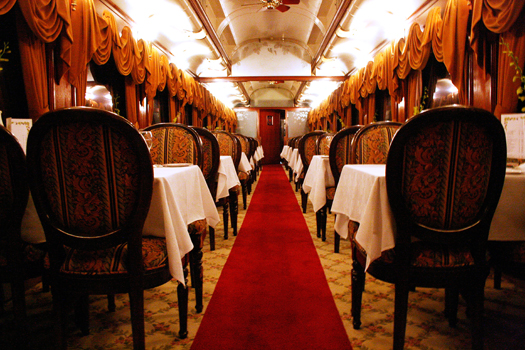 |
||
Napa Valley Wine Train Gourmet dining car |
||
The railroad's Wine List features 46 selections, including sparkling and dessert wines. Every course, and every item within a course, has a suggested wine pairing on the menu, and each is available by the glass. Ted selected, from the Gourmet Express Luncheon menu, the Baby Lettuce Salad with Candied Walnuts and Smoked Goat Cheese, Grilled Salmon served over Pappardelle Pasta and Sautéed Spinach in Champagne Ginger Cream with Crayfish Cake. Sylvia's entree was the Roasted Beef Tenderloin with Rosemary Potatoes and Grilled Squash in a Syrah Sauce. Edy chose the vegetarian selection, Spinach and Eggplant Wellington with Yam Stuffed Gypsy Peppers. These gourmet meals obviously took more work and preparation than an easy lasagna step by step recipe. Lasagna may not be considered a gourmet food but it is a wonderful comfort food. We all requested minor modifications, and since everything is prepared individually, that was accomplished graciously. All our dishes were attractively presented and delicious. |
|||||||||||
|
Various special events and activities are scheduled throughout the year, such as Moonlight Escape dinners in the dome, under the full moon. Murder Mystery Dinner Theater events inspire some guests to wear 1915-era costumes as they enjoy the 1915 Pullman Dining and Lounge. The Wine Education Dinner Series are popular, as are the Vintner Lunches. The price of $154 per person for the latter includes the participation of a guest vintner, as well as the presence of the company's own Wine Director and Executive Chef, and a special gourmet menu. Winery Tours and Lunch involve a stop for a private tour and tasting at one of the local wineries. Special holiday meals, including Thanksgiving Dinner, are served on board, and Santa joins the passengers on certain departures in late December. For more information, call your travel agent or Napa Valley Wine Train at 1 888 504 0975 or visit www.winetrain.com |
||
| Sylvia Blishak can be reached at: sylvia@traintravelconsulting.com | ||
| NAMED ONE OF THE WORLD'S TOP TRAVEL SPECIALISTS BY CONDE NAST TRAVELER MAGAZINE SINCE 2002. 3939 S. Sixth St. #331, Klamath Falls, OR 97603 Phone: 800 347 0645 Fax: 541 883 6457 |